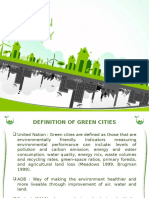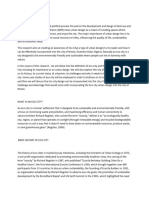Top 10 Sustainable Cities
Top 10 Sustainable Cities
Uploaded by
Bea LorinczCopyright:
Available Formats
Top 10 Sustainable Cities
Top 10 Sustainable Cities
Uploaded by
Bea LorinczOriginal Description:
Copyright
Available Formats
Share this document
Did you find this document useful?
Is this content inappropriate?
Copyright:
Available Formats
Top 10 Sustainable Cities
Top 10 Sustainable Cities
Uploaded by
Bea LorinczCopyright:
Available Formats
Top 10 sustainable approaches cities have taken that you need to know about
Cities all over the globe are becoming more and more conscious regarding their impact on the planet. Climate change, the exhaustion of non-renewable energy sources and general health are some of the essential issues a modern-day city has to face. Becoming aware of the actual ecological footprint of our settlements and trying to decrease them as much as possible are the most crucial goals our cities must set for the safe functioning of the ecosystem. Cityworld provides information about the latest and most efficient sustainable approaches taken by some of the greenest cities in the world. Here is a selection of the 10 most interesting initiatives: 10. Paris The city was amongst the winners, along with London, at the prestigious Sustainable Transport Award in 2008, the most esteemed distinction for ecological transport and urban liveability. A bicycle sharing programme named Vlib' has been lowering carbon emissions in Paris since its founding in 2007. A stock of 20,000 bicycles is serving the need of around 250,000 users. The next step will be the introduction of the electric bikes, currently in progress, which will raise the number of cyclists even more. Decreased speed limits are also a quick way of lowering CO2 emissions. Read more about Paris [http://www.cityworld.com/ce/detail/id/6538a5e18651-4dee-8c7c-bc08320c50db?37] or Vlib' [http://www.cityworld.com/la/detail/id/072ae8d1-9947-4dab-bb441262c36abbae?46] on Cityworld 9. The Hague also called the Green City at the sea, this city is full of parks and green areas, regardless of the proximity to the urban centre. The existence of so many planted outdoor areas leads to an increased health of the inhabitants. A number of 17 parks communicate with each other, through 12 ecological connection zones. These facilitate plant and animal migration, creating small, functional ecosystems. They are also great places for birds, insects and smaller mammals to hibernate. The closeness to nature is accentuated through the large number of bicycle paths, footbridges and horse trails, which help people to enjoy these beautiful surroundings.
The Hague offers its population a special bond with the natural habitat, encouraging eco-friendly transport and spending more time outdoors. Read more about The Hague [http://www.cityworld.com/ce/detail/id/03bca1f7-1fc8-4bb9-b10a-d540b518ee62? 52] on Cityworld
8. Panama situated between North and South America, Panama City has a unique location, between the tropical rainforests and the ocean. The most important source of income of the country is tourism: starting from the 90s, because of the beauty of its rainforests, Panama received a large flow of visitors. But, opposed to ecotourism, which explores exotic places and cultures, the city is now promoting sustainable tourism, which is much less invasive and ensures long-term preservation and conservation of the environment. It is also the key to mitigation of poverty and the rise of the quality of life. The Panama Canal, having around 77 km, makes the connection between the Atlantic and the Pacific Oceans. It is man-made, construction started in 1881 and was completed in 1914. It was one of the most difficult engineering projects ever created. The canal also preserves the rainforests, helping them to remain pure. Taking care of the natural resources that draw tourism to the area is the key ingredient for the future welfare of the country. Read more about Panama [http://www.cityworld.com/ce/detail/id/82576645-0df9-40dc-8194-89fb43fd8875? 26] on Cityworld 7. London it is one of the capitals of Europe and the world, but a sustainable way of transport was out of reach for Londoners: a study showed that the use of bicycles is rejected by many because of the lack of security of the bike lanes in the city. A decision was made: bike lanes would follow the Dutch model of segregated cycle roads. A new crossrail of 24 km will be available for cyclist by 2016, following the route of the Tube. The total investment reaches almost 1 billion, but its benefits will considerably reduce automobile pollution. Read more about Crossrail for bikes [http://www.cityworld.com/inspiring/detail/id/a4e2d853-87a7-4227-b93398da6eac0042?6] on Cityworld
6. Los Angeles The city has been making efforts to reduce its environmental impact. One of the most important active initiatives is Clean LA. With a strict set of rules, over the past years, electrical consumption was decreased by 28 % and water consumption reduced by 25 %. How did they do it? The goals included: replacement of diesel buses with compressed natural gas buses, mandatory low-flow toilets and shower heads since 1990 and all new buildings meeting high energy efficiency (LEED) standard. The future goals of Clean LA include reducing L.A.s greenhouse gas emissions 35 % below 1990 levels by 2030 and increasing the citys use of renewable energy to 40 % by 2020. Read more about Los Angeles [http://www.cityworld.com/ce/detail/id/5d73906a-f194-4fa8-afc5-8e4d708d647b? 24] on Cityworld 5. Madrid because of the good ratio between constructed and green areas, Madrid is listed amongst the 12 greenest cities in the world. Wherever you live in the city, a park is in a 15 minute walking radius. Casa de Campo is the largest urban park in Spain, covering 1,700 ha. One of the most spectacular interventions in the city is the creation of the Madrid Rio Park, which runs along 10 km and was established by burying underground a segment of the M-30 ring road, where it runs parallel with Manzanares River. The lush vegetation hosts cultural, sports and leisure facilities. Now the inhabitants of Madrid can enjoy the banks of the river without any barriers. Read more about Madrid [http://www.cityworld.com/ce/detail/id/05c85cc6-cbeb-47dd-92c1-58bc167401ce? 59] on Cityworld
4. Copenhagen Denmark was the first country to implement an environmental law, in 1973. In 2006 Copenhagen became the Environmental Capital of Europe and was chosen as the European Green Capital in 2014. Reducing CO2 emissions is one of the main environmental goals of the city, with 36 % of the population commuting by bike. The aim is to become the first carbon neutral capital by 2025. With a considerable investment in the sewage system, the quality of the water in the harbour has risen so that now people can actually swim in the water. The city managed to clean up its waters, after polluting
them with discharge from the sewage system. Now, wastewater is discharged in the harbour only during heavy rains. Read more about Copenhagen [http://www.cityworld.com/ce/detail/id/9a8f0a9b-43b4-4b8e-9fab-5b76a845378b? 25] on Cityworld
3. Gothenburg is standing in line amongst some of the greenest cities in the world, because of a series of sustainable initiatives applied. One of them is the development of the sustainable food concept. It is envisioned as a small-scale, locally produced industry. An area of 2,700 ha was used for developing public farms, where people can go and pick their on fruit and vegetable and pet the animals. The concept is to shorten the distance between the producer and the consumer, resulting in low costs for transportation. Following this principle, food trades are organised in the city centre. In 2012, Gothenburg was the Food Capital of Sweden. The country is also aiming to become the culinary nation of Europe by 2020. Read more about Gothenburg [http://www.cityworld.com/ce/detail/id/1fc36be9-8abd-4a3f-92d8-e18083238193? 49] on Cityworld
2. Curitiba due to a progressive master-plan dating back from the 1970s, Curitiba is recognised as one of the most sustainable cities on the globe. Amongst the steps to organise an eco-friendly city were an efficient public transport system, preserving woods and creating large green areas and waste separation. Curitiba was the first city in Brazil to introduce domestic garbage separation on a large-scale. The programme was named Lixo que no Lixo (garbage that isn't garbage) and is functioning since 1989. The Green Exchange Program consists of citizens trading recyclable materials for fresh, seasonable food. Poor people are encouraged to bring the food they grow but dont use to these green recycle centres, where they can trade. Recycling is so advanced, that two thirds of the citys daily waste is being processed. Although the program is voluntary, around 70 % of households participate! Read more about Curitiba [http://www.cityworld.com/ce/detail/id/88feef01-04d7-4212-b4f7-438467837ce7? 54] on Cityworld
1. Oulu functioning as an experimental winter-city, Oulu has the reputation of an innovative sustainable Swedish settlement. The local university conducts the researches and connects the entrepreneurs and the City Council. The main interest areas are reduction of energy and water consumption, reducing air pollution and resource efficiency. The new district of Hiukkavaara, housing 20,000 inhabitants, will become a living laboratory for sustainable practices in Northern Cities. Concerned also with the health of the community, sport facilities were planned and integrated throughout the area. Pedestrian and bicycle routes were carefully positioned, facilitating eco-friendly transport. Public transport was the second most important aspect in planning the roads. In bad weather, the interior routes are to be used, while the peripheral ones can be more enjoyable in the summer time. Read more about Oulu [http://www.cityworld.com/ce/detail/id/21d1f0ce7497-48bf-9af1-de38c677eb6d?53] on Cityworld
You might also like
- Sustainable City PPDocument15 pagesSustainable City PPmina alnuami100% (1)
- People vs. SingilDocument1 pagePeople vs. SingilDwight Anthony YuNo ratings yet
- UK Office Market Report Q4 2013Document16 pagesUK Office Market Report Q4 2013Bea LorinczNo ratings yet
- Competitive Profiel MetrixDocument4 pagesCompetitive Profiel MetrixJan Gelera100% (2)
- Esd Eco CityDocument15 pagesEsd Eco CityAndrew TorresNo ratings yet
- Eap116 Guut City Sustainable and LivableDocument9 pagesEap116 Guut City Sustainable and LivableTengis GanboldNo ratings yet
- Pristatymas Be PavadinimoDocument4 pagesPristatymas Be PavadinimoKajuzaszNo ratings yet
- Sustainable Cities Program - BriefDocument3 pagesSustainable Cities Program - Briefmathankumar.mangaleshwarenNo ratings yet
- Greencity1 170414084107Document10 pagesGreencity1 170414084107Bobinder chauhanNo ratings yet
- Green Policy: Alinda F.M Zain, Dept Landscape Architecture, IPB Galuh Syahbana, P4W-LPPM - IPBDocument40 pagesGreen Policy: Alinda F.M Zain, Dept Landscape Architecture, IPB Galuh Syahbana, P4W-LPPM - IPBTasyara FisqaNo ratings yet
- A Greener LondonDocument36 pagesA Greener LondonMatt Mace100% (1)
- Slide Present Green CityDocument18 pagesSlide Present Green CityEbulArh0% (2)
- Green CitiesDocument33 pagesGreen CitiesAina AyieNo ratings yet
- Green CityDocument2 pagesGreen CityFyqa HusniNo ratings yet
- Sustainability Report 2013Document35 pagesSustainability Report 2013EventsDCCNo ratings yet
- Eco-City: A Case Study of Dongton, ChinaDocument14 pagesEco-City: A Case Study of Dongton, ChinaShashikant Nishant SharmaNo ratings yet
- Top 10 Emerging Urban Innovations Report 2010Document16 pagesTop 10 Emerging Urban Innovations Report 2010JibranNo ratings yet
- Dockinfos: Transforming Ports, Changing CitiesDocument4 pagesDockinfos: Transforming Ports, Changing CitiesMuhammadZAmjadNo ratings yet
- Management SolutionsDocument6 pagesManagement SolutionsAryan ShahNo ratings yet
- The LINE ProjectDocument3 pagesThe LINE ProjectQuân Trần AnhNo ratings yet
- Sustainable Development PrinciplesDocument54 pagesSustainable Development PrinciplesShaik Hameed100% (1)
- Sustainable Development - ProjectDocument11 pagesSustainable Development - ProjectJATNIEL ANDRES SANTOS CHUNGANo ratings yet
- Sustainable Development Is The Organizing Principle ForDocument13 pagesSustainable Development Is The Organizing Principle ForNidal SajeerNo ratings yet
- Casus 1 EcocityDocument4 pagesCasus 1 Ecocityjan fransenNo ratings yet
- Module 6Document36 pagesModule 6RUSHALI SRIVASTAVANo ratings yet
- Urban Knowledge: The City Is The Key To Face The Problems of Our Time..Document12 pagesUrban Knowledge: The City Is The Key To Face The Problems of Our Time..Chandra Sekatr TNo ratings yet
- Urban DesignDocument9 pagesUrban Designenesisolomon7No ratings yet
- Ecological Cities - Copenhagen, Denmark - Seoul, South KoreaDocument4 pagesEcological Cities - Copenhagen, Denmark - Seoul, South KoreaCarlos Andres AndradeNo ratings yet
- Rogers Stirk Harbour-Paris 2030Document30 pagesRogers Stirk Harbour-Paris 2030Rahmat HidayatNo ratings yet
- Filinvest CityDocument2 pagesFilinvest CityJories LochingNo ratings yet
- Brief HistoryDocument15 pagesBrief Historyenesisolomon7No ratings yet
- Oslo ScriptDocument8 pagesOslo ScripttfdanaoNo ratings yet
- Assessment (A)Document8 pagesAssessment (A)nicholasNo ratings yet
- Tallinn: Towards The European Green Capital AwardDocument12 pagesTallinn: Towards The European Green Capital Awardgennadi_grambergNo ratings yet
- Sustainable Urban Utopia Rising - Masdar City's Visionary Journey To A Greener TomorrowDocument28 pagesSustainable Urban Utopia Rising - Masdar City's Visionary Journey To A Greener TomorrowKris GopalNo ratings yet
- Santiago BiofactoryDocument4 pagesSantiago Biofactoryel janeNo ratings yet
- Info GraphicDocument1 pageInfo GraphicDan MilesNo ratings yet
- SEZ, Self Sustained Communities, IntegratedTownshipsDocument75 pagesSEZ, Self Sustained Communities, IntegratedTownshipsvivedaa100% (1)
- OFID Wastewater Report 2018Document24 pagesOFID Wastewater Report 2018vedika maliNo ratings yet
- AmsterdamDocument18 pagesAmsterdamBetselot WondifrawNo ratings yet
- Alumni Photojournal: Where Architecture Meets EcologyDocument20 pagesAlumni Photojournal: Where Architecture Meets EcologyJasmine FlowerNo ratings yet
- Green CityDocument7 pagesGreen CityMadhvan GuptaNo ratings yet
- 10 Big Ideas FinalDocument24 pages10 Big Ideas Finalnabu_zainahNo ratings yet
- Gigantismul Urban vs. Oraşul EcologicDocument3 pagesGigantismul Urban vs. Oraşul EcologicLaurentiu BadescuNo ratings yet
- Topic 5 - A Proposed Urban Revitalization of P. Burgos St. Poblacion Batangas CityDocument5 pagesTopic 5 - A Proposed Urban Revitalization of P. Burgos St. Poblacion Batangas CityKat Alea UmaliNo ratings yet
- Pyramid City: Promoted by IP Direct Group October 2008Document30 pagesPyramid City: Promoted by IP Direct Group October 2008Shashank JainNo ratings yet
- The Reference Book Vol 2 - Inspiring Projects by Sapa Building SystemDocument120 pagesThe Reference Book Vol 2 - Inspiring Projects by Sapa Building SystemSapa Building System100% (4)
- Eco CityDocument10 pagesEco CityazzaazzahraNo ratings yet
- Causes, Consequences and Solutions To Sustainable Living in ZurichDocument5 pagesCauses, Consequences and Solutions To Sustainable Living in ZurichPhạm Huyền TrangNo ratings yet
- Propuestas de SoluciónDocument6 pagesPropuestas de SoluciónCarmen Toledo MirandaNo ratings yet
- Sustainable TransportDocument28 pagesSustainable TransportUMAIRNo ratings yet
- Symbio City Brochure English NEWDocument24 pagesSymbio City Brochure English NEWDaisyNo ratings yet
- Uiet Spartacus Develop A Solution That Reduces The Overall Waste and Optimizes Waste ManagementDocument12 pagesUiet Spartacus Develop A Solution That Reduces The Overall Waste and Optimizes Waste Managementmihir bhattNo ratings yet
- Sustainable Urbanism - EdinburghDocument15 pagesSustainable Urbanism - EdinburghJoakim Paz100% (3)
- Green Initiative: Since 1998 The Government Has Maintained Building Energy Codes, Which StipulateDocument3 pagesGreen Initiative: Since 1998 The Government Has Maintained Building Energy Codes, Which StipulateLeonardo Rivero DurianNo ratings yet
- Hammarby Sjostad Stockholm SwedenDocument5 pagesHammarby Sjostad Stockholm SwedenAlejandra SusaNo ratings yet
- CuritibaDocument3 pagesCuritibaJimBeeNo ratings yet
- Articles:: ST ST RDDocument7 pagesArticles:: ST ST RDDiego Ninanya VelardeNo ratings yet
- RRL 2Document20 pagesRRL 2Reigneth VillenaNo ratings yet
- CuritibaDocument4 pagesCuritibaLuis PinkmanNo ratings yet
- Asia Pacific Property Digest 4q 2016Document76 pagesAsia Pacific Property Digest 4q 2016Bea LorinczNo ratings yet
- 2012 Houston Economic Outlook PDFDocument13 pages2012 Houston Economic Outlook PDFBea LorinczNo ratings yet
- Miami Office Insight Q3 2013Document4 pagesMiami Office Insight Q3 2013Bea LorinczNo ratings yet
- 2 Q 13 Office Market ReportDocument4 pages2 Q 13 Office Market ReportBea LorinczNo ratings yet
- The Facebook ExperimentDocument17 pagesThe Facebook ExperimentBea LorinczNo ratings yet
- Edinburgh City Index: Stock Levels Rise Ahead of Tax Rate ChangeDocument2 pagesEdinburgh City Index: Stock Levels Rise Ahead of Tax Rate ChangeBea LorinczNo ratings yet
- Marketbeat: Industrial SnapshotDocument1 pageMarketbeat: Industrial SnapshotBea LorinczNo ratings yet
- Bangkok Retail 4q13Document1 pageBangkok Retail 4q13Bea LorinczNo ratings yet
- Bangkok Ind 4q13Document1 pageBangkok Ind 4q13Bea LorinczNo ratings yet
- Madrid Aag Logistics q1 2014 EngDocument2 pagesMadrid Aag Logistics q1 2014 EngBea LorinczNo ratings yet
- 2Q14 Atlanta Industrial Market ReportDocument4 pages2Q14 Atlanta Industrial Market ReportBea LorinczNo ratings yet
- Chennai Retail 2q14Document1 pageChennai Retail 2q14Bea LorinczNo ratings yet
- To Have and To Hold: Gratitude Promotes Relationship Maintenance in Intimate BondsDocument18 pagesTo Have and To Hold: Gratitude Promotes Relationship Maintenance in Intimate BondsBea LorinczNo ratings yet
- Ice Shells For Temporary Event ArchitectureDocument3 pagesIce Shells For Temporary Event ArchitectureAmi FloreiNo ratings yet
- Presentation WTP Tce GandhinagarDocument36 pagesPresentation WTP Tce GandhinagarDhaval Gadhia100% (1)
- Malaria Pregnancy NgassaDocument30 pagesMalaria Pregnancy NgassaMazterMaztermaztermazter MaztermaztermazterYandeNo ratings yet
- Cleaning ValidationDocument41 pagesCleaning ValidationDharmesh PatelNo ratings yet
- Stiklu Centrs Catalogue Oct 2010Document4 pagesStiklu Centrs Catalogue Oct 2010enkantoNo ratings yet
- Depression Is Not JokeDocument2 pagesDepression Is Not JokeMaria Katriel TejadaNo ratings yet
- Fascial AdhesionsDocument14 pagesFascial Adhesionsdevabakhti100% (1)
- Coordination & Response 2 QPDocument10 pagesCoordination & Response 2 QPnxtevie06No ratings yet
- Control of Environmental Pollution: 1. Preventive and Remedial Measures For Air PollutionDocument7 pagesControl of Environmental Pollution: 1. Preventive and Remedial Measures For Air PollutionPJ BhattacharyaNo ratings yet
- 1 DEE 1 SAFETY Add Knec QuestionsDocument7 pages1 DEE 1 SAFETY Add Knec QuestionsCOLLINS KIPRUTONo ratings yet
- The Gibbs Phase Rule For Multicomponent SystemsDocument11 pagesThe Gibbs Phase Rule For Multicomponent SystemsArun EbenezerNo ratings yet
- Reen STEM in The Elementary Classroom: Laura ArndtDocument9 pagesReen STEM in The Elementary Classroom: Laura Arndtapi-264560866No ratings yet
- Truck-Mounted Cranes: For Applications With Large Vehicles HB-R Series, The Perfect SolutionDocument4 pagesTruck-Mounted Cranes: For Applications With Large Vehicles HB-R Series, The Perfect SolutionRodrigo LealNo ratings yet
- Developing A Modified Logistic Regression Model For Diabetes Mellitus and Identifying The0 Important Factors of Type Ii DMDocument15 pagesDeveloping A Modified Logistic Regression Model For Diabetes Mellitus and Identifying The0 Important Factors of Type Ii DMDian PratiwiNo ratings yet
- Subject Title Electronic Engineering Materials Subject Code: 22217Document17 pagesSubject Title Electronic Engineering Materials Subject Code: 22217Tanishq MudaliarNo ratings yet
- Toba Tek Singh - Sadat Hasan Manto: SummaryDocument5 pagesToba Tek Singh - Sadat Hasan Manto: SummaryTanmai Naidu100% (8)
- LITERATURE REVIEW On Emlpoye MotivationDocument9 pagesLITERATURE REVIEW On Emlpoye MotivationAbhi JainNo ratings yet
- Fireray 50R100R UK Datasheet MAR19 - 0Document2 pagesFireray 50R100R UK Datasheet MAR19 - 0Cost RootsNo ratings yet
- Clinical Test - Lavender Water 3Document22 pagesClinical Test - Lavender Water 3Louis DePointeDuLacNo ratings yet
- Construction Roads DrainageDocument37 pagesConstruction Roads DrainageNur SalwaniNo ratings yet
- Apcoflor HFP - 120 MSDSDocument4 pagesApcoflor HFP - 120 MSDSdeekshithNo ratings yet
- Biochemistry Laboratory ReportDocument10 pagesBiochemistry Laboratory Reportmalakst200No ratings yet
- How Much Could We Boost Scholastic Achievement and IQ Scores A Direct Answer From A French Adoption Study.Document32 pagesHow Much Could We Boost Scholastic Achievement and IQ Scores A Direct Answer From A French Adoption Study.Maj ImanNo ratings yet
- Lecture Notes On Biostatistics.: February 2020Document179 pagesLecture Notes On Biostatistics.: February 2020kebedeNo ratings yet
- (p636-644) Metals Handbook. Volume 1, Properties and Selection Irons, Steels, and High-Performance Alloys PDFDocument9 pages(p636-644) Metals Handbook. Volume 1, Properties and Selection Irons, Steels, and High-Performance Alloys PDFSethGraceNo ratings yet
- Research Paper On NickelDocument6 pagesResearch Paper On Nickelgvznwmfc100% (1)
- MeggyDocument7 pagesMeggyAubrey Meg Y. GajeteNo ratings yet
- Six-Word MemoirsDocument6 pagesSix-Word MemoirsWBURNo ratings yet
- M10 - Partial Replacement of Fine Aggregate Using Polystyrene in Lightweight CHB-CE-503Document19 pagesM10 - Partial Replacement of Fine Aggregate Using Polystyrene in Lightweight CHB-CE-503Michelle LeeNo ratings yet








































































































